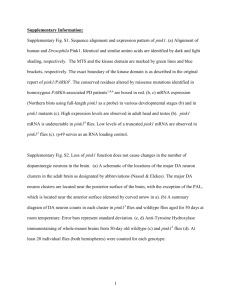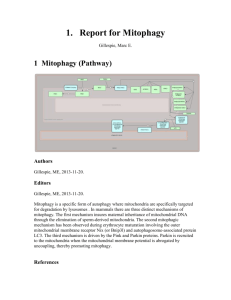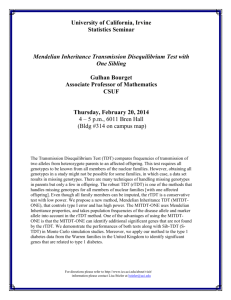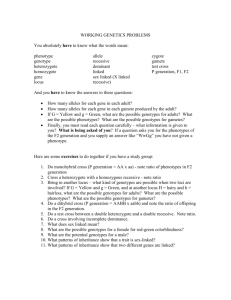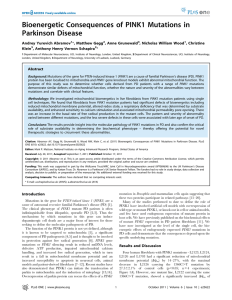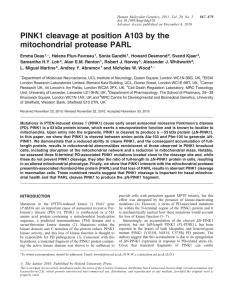Drosophila parkin: implication in juvenile Parkinson disease
advertisement
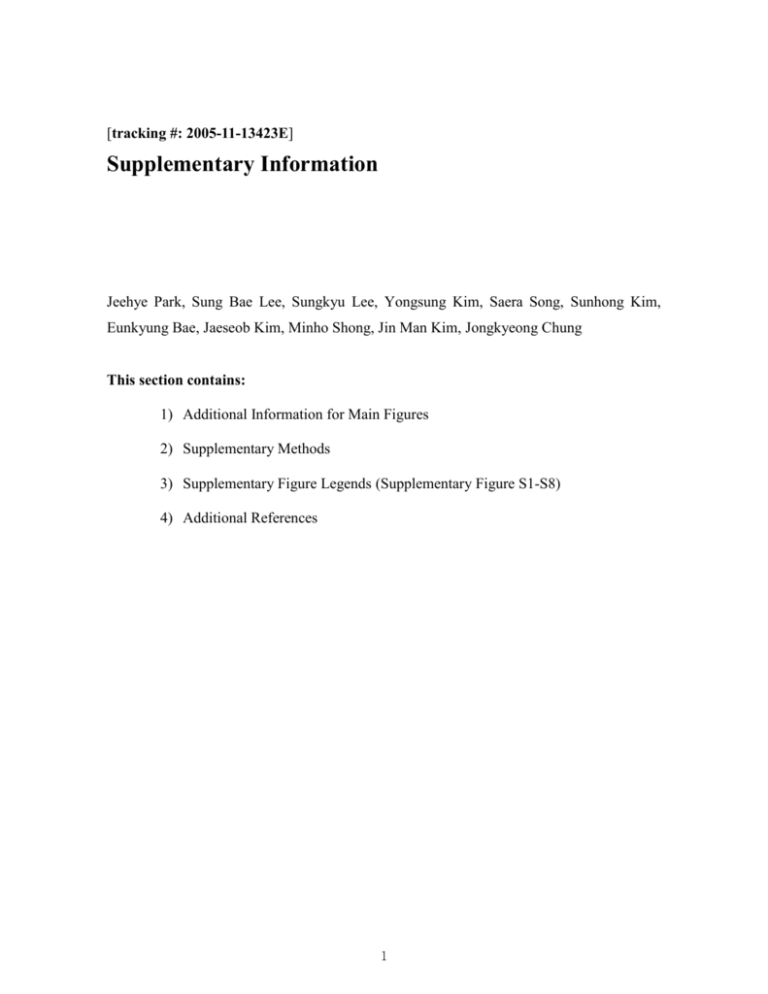
[tracking #: 2005-11-13423E] Supplementary Information Jeehye Park, Sung Bae Lee, Sungkyu Lee, Yongsung Kim, Saera Song, Sunhong Kim, Eunkyung Bae, Jaeseob Kim, Minho Shong, Jin Man Kim, Jongkyeong Chung This section contains: 1) Additional Information for Main Figures 2) Supplementary Methods 3) Supplementary Figure Legends (Supplementary Figure S1-S8) 4) Additional References 1 1) Additional Information for Main Figures Generation and characterization of PINK1 transgenic flies Drosophila PINK1 EST (clone #GH06623) was obtained from DGRC. The entire open reading frame (ORF) was subcloned into N-terminally HA-tagged pUAST vector. This generated construct was subjected to DNA sequencing for validation and then microinjected into w1118 embryos for generation of transgenic flies. Then, their expressions were checked by crossing with hs-GAL4 and thereafter conducting immunoblot analysis with anti-HA antibody (data not shown) and also with our generated anti-PINK1 rabbit antibody (Fig. 1c). Characterization of PINK1 mutants The PINK1D3 allele has lost 379bp, a deletion containing most of the second and third exons, including ATG, and the PINK1B9 570bp, from the second exon to the first fifty-five nucleotides of the fourth exon. Male sterility in PINK1 mutants PINK1 mutants did not contain matured sperms determined by linear morphology of nucleus stained by Hoechst33258 in the pouch called vas deferens in 3-day-old male testis. Due to sterility and its gene locus in X chromosome, males were the only mutant progenies obtainable. However, PINK1 mutant female (generated by mating heterogenous PINK1B9 female with transgene rescued PINK1 mutant male) was fertile. 2 Transgenic rescue experiments All transgenic rescue experiments with the hs-GAL4 driver were conducted at 25°C to minimize the transgene expression, which was high enough to rescue the phenotypes of PINK1 mutants. Muscle sections Thorax sections of the controls stained with toluidine blue show striated muscle fibers intactly attached together and their magnified sections show a clear vision of lines of dark blue mitochondrial spots between elongated muscle fiber bands in light blue color. The PINK1B9 mutants, however, show reduced muscle content and near-invisibility of mitochondria. IFM TEM analysis The revertants show electron-dense mitochondria intactly surrounded by regularly arranged myofibrils whereas PINK1B9 mutants show grossly swollen mitochondria. DA neuronal clusters DM, dorsomedial; DL, dorsolateral; PM, posteriomedial clusters. Quantification analysis All statistical analyses were performed using one-way ANOVA. For quantification of DA 3 neurons, 20 brains of each genotype were observed by all experimenters in a blind fashion to eliminate bias. To quantify DA cells with enlarged mitochondria, we calculated the percentage of the number of DA cells with mitochondria larger than 2 μm in diameter over the total number of DA cells in each cluster from 10 brains of each genotype. Mitochondrial genes used for the quantification of mtDNA level Co I and Co III: cytochrome c oxidase subunit I and III, respectively, Cyt B: cytochrome b. Genotypes Genotypes: WT (w1118); RV (PINK1RV/Y); D3 (PINK1D3/Y); B9 (PINK1B9/Y); hs>PINK1 (UAS-PINK1/Y; hs-GAL4/+); B9, hs>PINK1 (PINK1B9, UAS-PINK1/Y; hs-GAL4/+); park1 (+/Y;; park1/park1); B9, hs>Buffy (PINK1B9/Y; hs-GAL4/UAS-Buffy); WT, TH>mitoGFP (+/Y;; TH-GAL4, UAS-mitoGFP/+); B9, TH>mitoGFP (PINK1B9/Y;; TH-GAL4, UAS-mitoGFP/+); B9, hs>parkin (PINK1B9, UAS-parkin/Y; hs-GAL4/+); B9, TH>parkin, TH>mitoGFP (PINK1B9, UAS-parkin/Y;; TH-GAL4, UAS-mitoGFP/+); park1, hs>PINK1 (+/Y; hs-GAL4/UAS-PINK1; park1/park1); B9, park1(PINK1B9/Y;; park1/park1). 4 2) Supplementary Methods Fly stocks For validation of our PINK1 mutants, we generated PINK1 RNAi lines. The plasmid construct for this carries the C-terminal region of PINK1 (1,801bp~end in ORF) in pSymp vector. We also generated UAS-domi (a Drosophila homolog of HtrA2/omi) transgenic flies by subcloning their cDNA into the pUAST vector, followed by microinjection and their expressions were confirmed by immunoblot analysis. The TPH(serotonergic neuron-specific) GAL4 was generated by Dr. J. Kim (KAIST, Korea, unpublished). pucE69, the puckered-lacZ reporter fly strain, was kindly provided by Dr. T. Adachi-Yamada (Kobe University, Japan)12. The mef2-GAL4 fly line was kindly provided by Dr. E. N. Olson (University of Texas Southwestern Medical Center at Dallas)19. The hep1 fly line was a gift from Dr. S. Noselli (CNRS-University of Nice Sophia-Antipolis, France)13. The dilp2- (insulin-secreting cell-specific) GAL4 fly line was a generous gift from Dr. E. J. Rulifson (Stanford University School of Medicine)20. The UAS-p53 fly line was kindly provided by Dr. G. M. Rubin (University of California at Berkeley)21. The fly lines for UAS-lacZ and 24B-, gmr-, pdf- (circadian pacemaker cell-specific) and da-GAL4 were obtained from the Bloomington Stock Center (Bloomington, IN). Southern blotting and Quantitative PCR For Southern blot analysis, 10 g of total genomic DNA for each genotype was prepared by the conventional method, and was cut with EcoRI (KOSCHEM, Korea). 410bp 5 (Supplementary Fig. S1f) fragment of PINK1 ORF was used as a probe. For Real-Time PCR, total RNA was extracted by the Easy-Blue System (Intron, Korea), and reverse-transcribed using Oligo-dT Reverse Transcription Kit (Promega, WI). Then, PCR was performed using SYBR Premix Ex Taq (Takara) on iCycler iQ Multicolor Real-Time PCR Detection System (Bio-Rad). rp49 levels were measured for internal control. Results are expressed as fold change compared to the first indicated sample. S2 and HEK 293T cell culture, transfection, and immunocytochemistry The plasmid constructs for S2 cell transfection were generated by subcloning N-terminally HA-tagged PINK1 cDNA into pHym vector. S2 cells were grown in M3 media (Sigma S8398) supplemented with 10% IMS (Sigma 17267) at 25C and were transiently transfected by DDAB. The cells were preincubated with 5 g/mL MitoTracker Red CMXRos (Molecular Probes) for 30 min at 25C and then subjected to the standard immunocytochemistry. For HEK 293T transfection, PINK1 cDNA ligated into pcDNA3-FLAG vector was tranfected with Lipofectamine Plus method (Invitrogen). Immunocytochemistry was performed with anti-rabbit DYKDDDDK Tag (FLAG) antibody (Cell Signalling) and anti-mouse monoclonal MTC02 (mitochondria-specific) antibody (Abcam). Immunostaining and puc-lacZ reporter assay Adult brain, thorax muscle, and eye disc were fixed with 4% paraformaldehyde and blocked in TBST with 2% BSA. The primary antibodies used in this study: anti-HA 6 monoclonal mouse antibody (1:100, 6E2, Cell Signaling), anti-Myc monoclonal mouse antibody (1:100, 9E10), anti-TH rabbit antibody (1:50, Pel-Freez), anti--gal mouse antibody (1:100, DSHB, University of Iowa), and anti-tryptophan hydroxylase sheep antibody (1:100, Pel-Freez). Hoechst33258 (Sigma) was used to visualize the nucleus of muscles, and TRITC-labeled phalloidin (Sigma) to mark actin. Alexa 488-conjugated streptavidin (1:100, Molecular Probes) was used to mark mitochondria in IFM. puc-lacZ reporter assay was conducted as previously described16. Longevity and fertility assays Longevity and fertility assays were performed as previously described22. n=300 for longevity assay and n=50 for fertility assay. 7 3) Supplementary Figure Legends (Supplementary Figure S1-S8) Supplementary Figure S1 Characterization of Drosophila PINK. a, Sequence alignments of human (H), mouse (M), Drosophila (D) and C. elegans (C) PINK1. Red dotted bar indicates mitochondrial targeting motif (MTM) predicted by MitoProt program. Eleven subdomains of its kinase domain are marked by Roman numbers. b-c, Mitochondrial localization of PINK1. Subcellular localization of N-terminally HA-tagged PINK1 (b) or FLAG-tagged PINK1 (c) in S2 (b) or HEK 293T (c) cells determined by co-staining with anti-HA antibody (Green) and MitoTracker (Red) or with anti-FLAG antibody (Green) and MTC02 antibody (Red), respectively. d, Quantitative PCR analysis of PINK1 transcripts in developmental stages. E, embryo; L, larva; P, pupa; M, male; F, female. n=3. e, Quantitative PCR analysis of PINK1 transcripts in head (H), thorax (Th) and abdomen (Ab) of adult flies of different sex. n=3. f-g, Southern blot analysis. Red bar indicates the region used as a probe (f). Expected band sizes: 1.9 kbp for wildtype (WT) and revertants (RV), 1.5 kbp for PINK1D3 (D3) and 1.3 kbp for PINK1B9 (B9) (g). Bars indicate mean ± S.D. Supplementary Figure S2 PINK1-RNAi transgenic flies. For confirmation of PINK1B9 mutants, the expression levels, the defective thorax and wing phenotypes, and the structure of muscles were examined and compared between PINK1B9 mutants and PINK1B9, mef2>PINK1-RNAi flies. mef2>PINK1-RNAi flies in PINK1B9 background showed almost similar phenotypes of PINK1B9. a, Quantification of PINK1 transcripts in the thoraces of 3-day-old males of denoted genotypes. n=3. b, % of both defective thorax and wing 8 phenotypes of 3-day-old males of each genotype indicated. n>300. c, Longitudinally sectioned thorax images stained by toluidine blue. Black bar, 200 μm; orange bar, 20 μm. Genotypes: WT (w1118); UAS-PINK1-RNAi/mef2-GAL4); (PINK1RV/Y); RV B9 (PINK1B9/Y); B9, mef2>RNAi mef2>RNAi (+/Y;; (PINK1B9/Y;; UAS-PINK1-RNAi/mef2-GAL4). Bars indicate mean ± S.D. Supplementary Figure S3 Other phenotypes of PINK1 mutants. a, Reduced lifespan of PINK1 mutant males. The numbers of surviving males were counted at the indicated days, and the survival ratios were presented as percentile values. n>300. b, Quantitative analysis of the wing phenotypes of indicated genotypes over time. c, TEM analysis of the mitochondria of IFM. Magnified views of the red-dotted boxes are also presented on the right of each panel. The region of mitochondria with loss of the outer membrane in PINK1 mutants was marked with arrowheads. Orange bar, 200 nm. Genotypes: WT (w1118); RV (PINK1RV/Y); B9 (PINK1B9/Y); park1 (+/Y;; park1/ park1); B9, hs>PINK1 (PINK1B9, UAS-PINK1/Y; hs-GAL4/+). Bars indicate mean ± S.D. Supplementary Figure S4 Suppression of PINK1 mutant phenotypes by Bcl-2. a, Western blot of mtProtein of thoraces. The protein levels of Co III of fly-thoraces of indicated genotypes were determined by using anti-Co III antibody. Tubulin immunoblot for loading control. Asterisk indicates a nonspecific band. n=3. b, Longitudinally sectioned thorax images (upper panels), and merged images (bottom panels) of TUNEL (Red) and Hoechst33258 (Blue) staining of the thorax of the indicated genotypes. Orange bar, 20 μm. 9 c, Quantification of the mtDNA of thoraces of 2-day-old males by PCR. Co I and Co III: cytochrome c oxidase subunit I and III, respectively, Cyt B: cytochrome b. n=3. d, Comparison of the ATP content of thoraces of 2-day-old males between the indicated genotypes. n=3. e, Comparison of the climbing rate between 3-day-old males of indicated genotypes (*, P=4.5910-4; **, P=3.3910-3). f, Comparison of the flight ability between 3 day-old males of indicated genotypes. n>100. Genotypes: WT (w1118); RV (PINK1RV/Y); B9 (PINK1B9/Y); B9, hs>PINK1 (PINK1B9, UAS-PINK1/Y; hs-GAL4/+); B9, hs>Buffy (PINK1B9/Y; hs-GAL4/UAS-Buffy); hs (+/Y; hs-GAL4/+); hs>Buffy (+/Y; hs-GAL4/UAS-Buffy); mef2 (+/Y;; mef2-GAL4/+); mef2>Buffy (+/Y; UAS-Buffy/+; mef2-GAL4/+). Bars indicate mean ± S.D. Supplementary Figure S5 DA neuronal degeneration in PINK1 mutants. a, Immunostaining with anti--gal antibody to mark DA neurons of TH>lacZ and B9, TH>lacZ. White bar, 100 m. b, Graph showing the number of DA neurons in each cluster at 30 days. Each bar represents mean ± S.D. from 20 different brains (*, P=3.9910-3; **, P=1.0010-3). c, Examination of the mitochondria in DA neurons of adult brain. TH-GAL4 driven expression of mitoGFP is presented in green. Immunostaining with anti-TH antibody was performed to mark DA neurons in adult brain (Red). Merged images are also presented. White bar, 100 m. d, Magnified images of the DA neurons in all major clusters of brains of 3-day old males. Orange bar, 10 m. Genotypes: TH>lacZ (+/Y; UAS-lacZ/+; TH-GAL4/+); B9, TH>lacZ (PINK1B9/Y; UAS-lacZ/+; TH-GAL4/+); WT, TH>mitoGFP (+/Y;; TH-GAL4, UAS-mitoGFP/+); B9, TH>mitoGFP (PINK1B9/Y;; TH-GAL4, 10 UAS-mitoGFP/+). Bars indicate mean ± S.D. Supplementary Figure S6 Mitochondrial morphology in other neurons of PINK1 mutants. a-c, TEM analysis of mitochondria in various neuronal cells in brains of 20-day-old males. TEM images of the surrounding cell bodies of DA neurons in posterior protocerebrum (a), neuropils in posterior protocerebrum (b) and photoreceptor (R) cells (c) are presented. Red arrows indicate the mitochondria in the cells. n, nucleus. White bar, 2 m; orange bar, 1 m. d-f, Examination of the mitochondria in various neurons of 3-day-old adult brains. TPH(d), dilp2- (e) or pdf- (f) GAL4 driven expression of mitoGFP (Green) was used. Immunostaining with anti-tryptophan (Trp) hydroxylase antibody was performed to mark serotonergic neurons in adult brains (Red). White and red arrows indicate serotonergic neurons in supraesophageal ganglion SP1 and neuropil LP1 clusters, respectively. White bar, 100 m; orange bar, 10 m. Genotypes: WT (w1118); B9 (PINK1B9/Y); WT, TPH>mitoGFP (+/Y; TPH-GAL4/+; UAS-mitoGFP/+); B9, TPH>mitoGFP (PINK1B9/Y; TPH-GAL4/+; UAS-mitoGFP/+); WT, dilp2>mitoGFP (+/Y; dilp2-GAL4/+; UAS-mitoGFP/+); B9, dilp2>mitoGFP (PINK1B9/Y; dilp2-GAL4/+; UAS-mitoGFP/+); WT, pdf>mitoGFP (+/Y; pdf-GAL4/+; UAS-mitoGFP/+); B9, pdf>mitoGFP (PINK1B9/Y; pdf-GAL4/+; UAS-mitoGFP/+). Supplementary Figure S7 Genetic interaction analysis between PINK1, Parkin and the JNK pathway. a, Quantification of the mtDNA of the thoraces of 2-day-old males by PCR (Only the P values for Co III are shown: *, P=1.2110-3; **, P=2.8710-2). n=3. b, 11 Comparison of the ATP content of thoraces of 2-day-old males between the indicated genotypes (n=3; *, P=7.2010-4; **, P=6.6010-2). c, Inability of Parkin to suppress apoptosis and the consequent eye phenotypes induced by gmr-GAL4 driven expression of various apoptotic molecules. TUNEL assay was conducted with eye imaginal discs to detect apoptosis (Red). Parkin expression was examined by immunostaining with anti-Myc antibody (Blue). Genotypes: WT (w1118); RV (PINK1RV/Y); B9 (PINK1B9/Y); B9, hs>parkin (PINK1B9, UAS-parkin/Y; hs-GAL4/+); gmr, (+/Y; gmr-GAL4/+); gmr>Myc-parkin (UAS-parkin/Y; gmr-GAL4/+), gmr>p53 (+/Y; gmr-GAL4/UAS-p53), gmr>p53+Myc-parkin (UAS-parkin/Y; gmr-GAL4/UAS-p53), gmr>domi (+/Y; gmr-GAL4/+; UAS-domi/+), gmr>domi+Myc-parkin (UAS-parkin/Y; gmr-GAL4/+; UAS-domi/+), gmr>caspase-1 (+/Y; gmr-GAL4/UAS-caspase-1), gmr>caspase-1+Myc-parkin (UAS-parkin/Y; gmr-GAL4/UAS-caspase-1). Bars indicate mean ± S.D. Supplementary Figure S8 Characterization of PINK1 and Parkin interaction. a-b, Comparison of the flight ability (a, n>100) and the climbing rate (b) between 3-day-old males of indicated genotypes. c-d, % of defective thorax (c) and wing (d) phenotypes of males of each genotype indicated. n>300. e-f, In vivo localization of PINK1 and Parkin. anti-HA (e) or anti-Myc (f) antibody, Blue; streptavidin, Green; phalloidin, Red. White bar, 20 m; orange bar, 5 m. g-i, Suppression of the apoptosis of PINK1 mutants by inactivation of JNK pathway. g, puc-lacZ assay with the IFM of 2-day-old males of indicated genotypes containing heterozygous pucE69 allele. Black bar, 200 m; orange bar, 12 50 m. h, % of defective thorax and wing phenotypes of males of each genotype indicated. n>300. i, Longitudinally sectioned thorax images stained with toluidine blue (upper and middle panels), and merged images (bottom panels) of TUNEL (Red) and Hoechst33258 (Blue) staining of the thorax of the indicated genotypes. Black bar, 200 μm; orange bar, 20 μm. Genotypes: WT (w1118); RV (PINK1RV/Y); B9 (PINK1B9/Y); park1 (+/Y;; park1/park1); park1, hs>PINK1 (+/Y; hs-GAL4/UAS-PINK1; park1/park1); B9, park1 (PINK1B9/Y;; park1/park1); hs>HA-PINK1 (UAS-PINK1/Y; hs-GAL4/+); hs>Myc-parkin (UAS- parkin/Y; hs-GAL4/+); WT, puc-lacZ (+/Y;; pucE69/+); B9, puc-lacZ (PINK1B9/Y;; pucE69/+); B9, hep1 (PINK1B9, hep1/Y). Bars indicate mean ± S.D. 13 4) Additional References 19. Ranganayakulu, G., Schulz, R. A. & Olson, E. N. Wingless signaling induces nautilus expression in the ventral mesoderm of the Drosophila embryo. Dev Biol 176, 143–148 (1996). 20. Rulifson, E. J., Kim, S. K. & Nusse, R. Ablation of insulin-producing neurons in flies: growth and diabetic phenotypes. Science 296, 1118-1120 (2002). 21. Brodsky, M. H. et al. Drosophila p53 binds a damage response element at the reaper locus. Cell 101, 103-113 (2000). 22. Lee, J. H. et al. In vivo p53 function is indispensable for DNA damage-induced apoptotic signaling in Drosophila. FEBS Lett. 28, 5-10 (2003). 14
